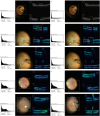Clinical significance of signal shadowing during intraoperative optical coherence tomography-assisted vitreoretinal surgery
- PMID: 38443491
- PMCID: PMC10914830
- DOI: 10.1038/s41598-024-56125-y
Clinical significance of signal shadowing during intraoperative optical coherence tomography-assisted vitreoretinal surgery
Abstract
This study aimed to analyze the clinical significance of signal shadowing during intraoperative optical coherence tomography (iOCT)-assisted vitreoretinal surgery caused by vitreoretinal instruments, tissue dyes, and vitreous substitutes, and to objectively quantify its impact on iOCT imaging. This is a retrospective observational study of postoperative image analysis from one hundred seventeen (117) patients who underwent iOCT-assisted vitrectomy. The image data were divided into three groups: vitreoretinal instruments, tissue dyes, and vitreous substitutes. The data was then processed using graphic software to measure the grade of picture quality distortion and compared to paired image controls without clinically perceptive interference, then analyzed statistically. The intraocular portion of all studied vitreoretinal instruments caused a high average gray level interference compared to controls ranging from 32 to 68% reduction, obscuring the area of interest significantly. The tips of the instruments produced low-grade shadowing, allowing the underlying tissue to be distinguished. The analyzed dyes demonstrated a wide interference range: ICG (- 75.12%), and triamcinolone (- 26.13%) showed dose-dependent high shadowing, while VITREODYNE™ (49.3%) and brilliant blue G (14.06%) exhibited no perceived distortions whilst increasing average gray levels. All analyzed vitreous substitutes (air, SF6, C3F8, PFCL, and silicone oil) showed an insignificant shadowing effect on iOCT. Certain dyes and vitreous substitutes produce a negligible shadowing effect compared to controls and other dyes, providing an advantage during real-time iOCT imaging. All analyzed vitreoretinal instruments showed a significant interference that should prompt the development of new imaging techniques or the implementation of materials with low-grade interference to overcome a clinically relevant shadowing effect on iOCT, maximizing the technology's visual accuracy and surgical diagnostic aid proficiency.
© 2024. The Author(s).
Conflict of interest statement
The authors declare no competing interests.
Figures



Similar articles
-
The value of intraoperative optical coherence tomography imaging in vitreoretinal surgery.Curr Opin Ophthalmol. 2014 May;25(3):221-7. doi: 10.1097/ICU.0000000000000044. Curr Opin Ophthalmol. 2014. PMID: 24614147 Free PMC article. Review.
-
Intraoperative Optical Coherence Tomography in Vitreoretinal Surgery.Semin Ophthalmol. 2019;34(4):312-316. doi: 10.1080/08820538.2019.1620811. Epub 2019 Jun 26. Semin Ophthalmol. 2019. PMID: 31240975 Review.
-
Use of iOCT in Vitreoretinal Surgery for Dense Vitreous Hemorrhage in a Chinese Population.Curr Eye Res. 2019 Feb;44(2):219-224. doi: 10.1080/02713683.2018.1533982. Epub 2018 Oct 18. Curr Eye Res. 2019. PMID: 30299988
-
Use of Handheld Intraoperative Spectral-Domain Optical Coherence Tomography in a Variety of Vitreoretinal Diseases.Ophthalmic Surg Lasers Imaging Retina. 2016 Jan;47(1):49-54. doi: 10.3928/23258160-20151214-07. Ophthalmic Surg Lasers Imaging Retina. 2016. PMID: 26731209
-
Intraoperative Optical Coherence Tomography in Vitreoretinal Surgery.Cesk Slov Oftalmol. 2017 Fall;73(3):94-100. Cesk Slov Oftalmol. 2017. PMID: 29394075 English.
References
-
- Baskaran, K., & Wildsoet, C. Optical Coherence Tomography (OCT): Newer technologies and technical challenges. Scand. J. Optomet. Vis. Sci.15(1). 10.5384/sjovs.v15i1.154 (2022).
-
- Binder, S., Falkner-Radler, C. I., Hauger, C., Matz, H., & Glittenberg, C. Feasibility of intrasurgical spectral-domain optical coherence tomography. Retina (Philadelphia, Pa.), 31(7), 1332–1336. 10.1097/IAE.0b013e3182019c18 (2011). - PubMed
Publication types
MeSH terms
Substances
LinkOut - more resources
Full Text Sources

